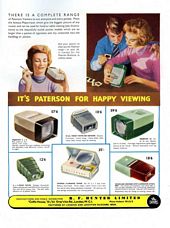| Paterson Products Ltd - distributed by R.F.Hunter |
| Following the production of the first of their famous developing tanks in 1950, Paterson's range of quality equipment expanded into all aspects of darkroom work, both hardware and chemistry. | ||
  |
The Hunter logo was a horse & rider, jumping a fence. In the bars of the fence it reads "The Hunter Series". The full name of R.F.Hunter was Robert Forgie Hunter. |
|
|
Robert Hunter's grandson, Andy (Andrew) Hunter, and the grandson of Arthur Blackburn, Robin Selby, have sent me much family history research about R.F.Hunter. Click the button opposite: One of Andy's god-parents was Arthur (Blackie) Blackburn (see below). |
||
 |
R.F.Hunter became a well known country-wide dealer in, and agent for, photographic materials, as well as the boxed, pop-up film, cine or slide projector screen marketed under the brand name CELFIX. The advertisement shown left (taken from Amateur Photographer magazine for October 7th 1931), shows that the CELFIX screen was being sold by R.F.Hunter Ltd by the early 1930s, at that time from 40 Doughty Street, London, W.C.1. Interestingly, these screen were not the square 40ins x 40ins as became a common size for home projection; the square format meaning that vertical and horizontal 35mm slides could both be projected without over-flowing the screen. These screens pre-date 35mm colour slides (transparencies) and, as the advert makes clear, were intended for ciné film projection and had a horizontal format to suit cine film frame proportions. |
|
 |
The home ciné film format in use at the time of the CELFIX being introduced, would have been 16mm, brought out by Kodak in 1923. This was expensive for amateur (home) use, but R.F.Hunter was possibly preparing for the arrival of the new, lower cost, 8mm home ciné format, introduced by Kodak in 1932 (USA) and which appeared in the UK in Spring 1933 (ref: The Home Photographer and Snapshots, advert p77, April 1933). 16mm home ciné colour film, named Kodacolor, appeared in 1928. Improved colour in the form of Kodachrome arrived in the 16mm ciné format in 1935 and by 1936 Kodachrome was also available in 8mm ciné and 35mm still formats. Kodak, in their 'The "Kodak" magazine' dated January 1931, claimed that in Great Britain and Ireland there were, in 1930, "well over 50,000 amateur cinematographers". Alongside is an advert (from 1938) for the Ciné-'Kodak' Eight, price, including carrying case, "from £10". Black & white 8mm panchromatic cine film cost 10shillings a reel (50p) which lasted 4minutes. Kodak claimed that such a film, used to take 20-30 separate sequences, would cost 4d-6d (2p-2.5p) a 'shot'. but each sequence would only have lasted 8sec to 12secs. The equivalent projector would have been one of the series called "Kodascope". 'Ciné Kodak' and 'Kodascope' were Kodak cinematography trade names that first appeared in 1923. |
|
|
The phrase 'Paterson Products' was used by R F Hunter to collectively refer to the growing range of Paterson darkroom (and slide viewing) equipment from the mid-1950s. Click here to go down this page to the start of that chronology. Paterson first started to be distinguished as the manufacturer of an equipment range in its own right when the 'soon to become famous' logo (shown above left) first appeared, possibly early 1963. By December 1965, Paterson items bear the label 'Paterson Product' made in England for R.F.Hunter Ltd, London. Exactly when Paterson became a Ltd company, trading under the name Paterson Products Ltd, is not yet certain. It may have been as early as 1963, when the Paterson logo first appeared, but was certainly the case by late 1967. If the latter, then it may be that Paterson Products Ltd was formed out of R.F.Hunter Ltd when Johnsons of Hendon took over the distribution of Paterson equipment. |
||
| Below is a table containing pictures of the covers of a series of booklets and advertising literature for Paterson equipment dating from the mid-1950s through to the late 1990s. | ||
| The name Paterson
still exists in the world of photographic equipment supply. They
can be contacted at: Paterson Photographic Limited, 2 Malthouse Road, Tipton, West Midlands, UK. DY4 9AE. Telephone: 0121 520 4830; Email: sales@patersonphotog.plus.com. They still offer a wide range of photographic darkroom products. |
||
|
Return to the Home page: |
|
|
|
For History relating to (especially Paterson) Developing Tanks: |
|
|
|
Early history of the Paterson company, and its founder Donald (MacDougal) Paterson: |
|
|
| Paterson introduced its own comprehensive range of monochrome chemistry, starting with Acutol, a fine grain, high acutance, developer in autumn 1963. It was invented by Geoffrey.W Crawley. Sold in screw-capped 220cc (7.5 fluid ounce) bottles, requiring to be diluted 1:6. As this chemistry acquired a high reputation and the range extended, it became known collectively as the Paterson 'Acu' chemistry range. | ||
|
Chronology and product information relating to the 'Acu' chemistry range, click here: |
|
|
| Currently (2009) Paterson's monochrome chemistry range is much reduced from what it once was, being three types of developer, all available in 1litre bottles. They are Aculux 3 (fine-grain film developer), FX-39 (high-definition film developer) and Acugrade print developer. There is also Acufix, the 'High Speed Fixer'. | ||
|
For general history relating to the Paterson company and its products post-1985: |
|
|
|
"Arthur Blackburn has retired from the chairmanship of R.F.Hunter Ltd after 52 years in the photographic trade. Blackie, as he is known to so many, joined Hunters, now a subsidiary of Johnsons of Hendon, in 1924, four years after the firm's inception. Perhaps his most significant contribution to its prosperity was the signing of an agreement in 1929 with Paul Franke of Franke & Heidecke whereby Hunter became agents for the Rollei (a new agreement was signed in July 1966). The interests he took into retirement were yachting and gardening, as well, of course, photography." When Johnsons was acquired by the Hestair Company and underwent major restructuring and abandoned chemical production in 1974, Paterson took over production of booklets similar to the Johnsons of Hendon ~ 'Home Photography' series. Similarities with the Johnsons 'Home Photography' series include the Paterson 'Book of Photography' also being edited by Kevin MacDonnell, the printers also being Sawtells of Sherborne, Dorset, and number of pages also being 104. This was confirmed to me by Alan Meek in an e-mail he sent in September 2005. Alan said: "I started working for
Paterson in 1968 and became Technical Manager of the company
until I left in 1981. I was responsible for the production of
the majority of the (Paterson) publications you illustrate. For
many years before 1975 Johnsons of Hendon published successive
copies of the Book of Photography (Alan means the 'Home Photography'
series) which was written by Kevin
MacDonnell (and 'Pip'
Pippard). When Johnsons decided to cease publication Kevin
came to Paterson with an updated (and Paterson orientated) version
so we added to it and published our version. Over the years we
updated it and e Much of the writing was done by our General Manager George Ashton, who had joined us from Ilford Ltd. I too wrote many of the chapters. You mention Richard Bradford and David Morris, who were both photographers at Paterson. Some time after I left, Paterson approached me to write the new chapters for the 1987 revision so that it covered the latest chemicals and the enlarger/timer/analyser items for which Paterson had just purchased the manufacturing rights from Philips". Practical Photography in their April and May 1980 issues refer to George Ashton as "one time editor of Popular Photography (a US magazine that led to production of the UK magazine Practical Photography in 1959) and now Technical Director of Paterson products Ltd, with Mr.P.W.Deer being the Managing Director." Richard Bradford, as mentioned by Alan Meek (above), joined Paterson Products in July 1974, straight from school, as a Photographic Assistant earning a princely £800 p.a. (yes ! eight hundred !). He worked "down in the studio / darkroom at 2-6 Boswell Court, WC1N 3PS. Boswell Court was Head Office at the time, with manufacturing being carried out in a relatively new factory in Dagenham. Richard was enthusiastic and was rewarded by being allowed 'Day Release' (one day per week) from Paterson, to study at the School of Photography in Harrow College of Technology & Art. Harrow College was excellent at the time but has since been swalled up / amalgamated with some other Institution. |
||
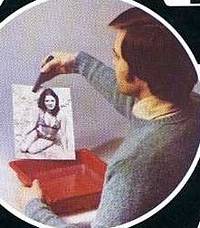 John Piggott |
Richard started work with John Piggott, photographer, whose picture is in the bottom-right segment the cover of the 'Paterson Book Of Photography' (see below - enlarged to the left). John emigrated to Canada in late 1974 or early 1975. David Morris (see mention above by Alan Meek, and also below, as a photographer involved with the Paterson Book Of Photography) had been a catalogue photographer at Heals before joining Paterson. So when subsequently he was asked how long he worked at Patersons he'd say '5 catalogues'... He eventually moved to Wakefield and continued catalogue work for one of the mail-order houses. Richard and he are still in touch. Richard says "David was much more at home in the studio, and it was me who seemed to do much of the darkroom work". "About 1975, to celebrate Paterson's 25 years, it was decided to take a photograph of the entire range of products, rather like the double-page '1970s' picture(below). This involved hiring a large studio (I think through Pelling and Cross) and a 10x8 camera, not to mention getting one-of-everything there. |
|
|
"Chemical production was going on at Dagenham, and each batch would be sent up to Boswell Court for testing. I cannot remember how acceptability was judged in the early days, but not long after I joined we got a sensitometer and densitometer. If I remember correctly, a batch of developer was accepted if it fell within 1/3 f-stop of the norm. The early batches of Aculux (supposed to be Paterson's liquid standard developer, i.e. to rival D-76 and ID-11) produced some notoriously contrasty negs with FP4 when metered correctly, but was fine with Tri-X. HP5 was always a bit thin..." "The main reason, though, for getting the sensitometer was because Paterson was moving into colour film and paper chemistry (C41 and EP2 equivalents). Under the guidance of Geoffrey Crawley, this was handled by George Ashton. Testing under 'real' amateur-like conditions fell to me. Yes, roll upon roll of colour neg film was exposed and processed with a sensitometer strip in spiral developing tanks... We even tray-processed colour paper to test the chemistry's exhaustion point; normal testing was, of course, drum processed. In effect, I was a machine..." "The other revolution at the time was the introduction of resin-coated paper, which drastically cut processing, especially washing, time. Paterson brought out a range of processing aids. I remember we had regular visits from the Ilford rep, whose paper we used, but not from Kodak". "Boswell Court was also home to medium-format (roll film) 'texture screen' production. These were thin negatives of patterns which the photographer / printer could put into the enlarger's negative carrier with his / her own negative to produce a pattern on the print. They had quite a following, but each to their own... The film used for the texture screens was Panatomic-X, owing to its fine grain. This was specially produced for Paterson by Kodak in bulk rolls; these were loaded into magazines and fed though a Homrich camera. Dagenham produced the 35mm equivalent screens." "Of course, the major event during the time I was there was Donald Paterson's (always referred to as 'Mr Paterson' of course) death on 3rd August 1975. He was a regular visitor to the darkroom / studio; imagine, a boss who actually new something about the products he made and sold and did not just regard them as production and sales figures... Donald Paterson's death was doubly unfortunate since he had been due to sign a finance deal upon his return from holiday." "Donald Paterson was a Leica (SLR) man, which he used for his African (Kenya) wildlife photos; I think it may have been those photos which earned him the FRPS. He may also have used Hasselblad as well, although I never saw him with one."
"For catalogue work, there was a Cambo 5x7" monorail (see left), invariably used with a 4"x5" back, with 150mm and 210mm (Rodenstock?) lenses, all mounted on a Cambo studio stand. In other words, all this was pretty much standard photographer's equipment for the time. Except for the studio flash. Paterson were Rollei's UK distributor at the time and produced some well-built but rather under-powered studio flash lights; for most product shots, even when relatively closely lit, 2 flashes were required." "We had sheet and roll film processed in a lab in the basement of Neal's Yard, Covent Garden; the walk or short tube ride there (it made little difference to the journey time) gave us some fresh air and daylight." |
||
|
Tim Norgate learned of this web page from Richard Bradford and e-mailed (May 2010) to say he also (as had Richard) joined Paterson in 1974 "when they were in Bedford Row, Holborn and a few weeks later they moved to Boswell Court". "I worked for Alan Meek in Customer Relations until 1979 when they decided to carry out there own distribution within the UK. To be a Sales Representative for Paterson I moved to Birmingham to be responsible for the Midlands Territory. My Sales Manager was Clive Brown and a couple of years later Mike Allen, who had come from what had been Johnsons and then Hestair". "I worked as the Midlands Rep. for about 10 years but left soon after the company was bought by Photax. In 2002 I was made redundant from CZ Scientific and became a Sales Agent working for several Companies including Paterson Products, but digital darkroom had taken its toll and it was a much smaller business. Today I am still a sales agent for a Binocular Company and I run my own Pinhole Camera website". |
||
|
"A second room was for printing - a De Vere 504 enlarger (left) with condenser head and glass negative carrier, equipped with Rodenstock Rodagon lenses, a Paterson 35mm enlarger with a Leica enlarging lens (an excellent combination, the enlarger featuring a flat underside to the condenser which pressed the negative flat). The Paterson enlarger had a filter drawer for colour printing. The filters Paterson supplied for colour printer were from Lee Filters. There may have been a third enlarger, but it wasn't regularly used." "Rounding off the darkroom was a finishing / mounting room. This had a large drum glazing machine which needed some TLC to get a consistently good glaze on non-RC (non-Resin-Coated) 'glossy' papers; when RC papers came along we 'sandwiched' the prints between photographic blotting paper and the cloth belt, since otherwise the surface next to the drum would not dry. Heating in the room also came from a flat-bed mounting press. It got pretty warm in there!" |
||
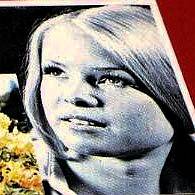 Barbara 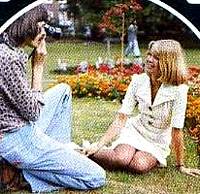 |
"Within very generous limits - never reached in practice - Paterson let anyone who wanted to, to use company film, paper and chemicals for their own purposes. This was on the principle that we could provide invaluable feedback and real-world experience. As far as I know, no-one abused this privilege by running their own business. Likewise, we took care not to do 'private' work in company time or to leave it lying around. For one thing we were pretty busy, and for another you would never know if one of the directors was going to pop in... I know this strays a little from a straight history, but perhaps it helps put things in context." "One final note. Paterson produced a catalogue featuring a silhouette of a male figure carrying a box with a Paterson logo (no copy on this site at this time)." The 'model' was Richard. "Those who saw the result claimed to recognise my gait!" "All artwork for Paterson's ads and catalogues was done by a graphic artist called, I think, Rabley." The other director at the time was T.A. (Alan) Bailes. There was also Ian Stears and David Murray who took care of exports. Our paths occasionally crossed later at places like Photokina, but I wonder what happened to them. Alan Meek was the Technical Manager and what would now be called the Line Manager for the darkroom / studio staff. He had an assistant, Tim Norgate, who I think stayed with Paterson after they moved to the West Midlands; I think he also had something to do later with a range of pinhole cameras. Alan Meek's secretary was Barbara, the blonde who you can see on the cover of the 'Book Of Photography' and 'Book Of The Darkroom' (for enlarged sections, see left). Richard Bradford left Paterson Products at the end of 1976 and subsequently worked for Agfa-Gevaert and De Vere |
|
| The following table begins by illustrating the booklets produced by Paterson after the demise of Johnsons of Hendon and their 'Home Photography' boklet series (see paragraphs above). Then, at the end of the table are pamphlets and magazine pages advertising Paterson equipment from 1956 to 1998. In these, I have tried to trace some of the chronology of Paterson's move into complete home darkroom outfits (their successful 'darkroom in a box' idea) for black & white and for colour printing. Also their colour chemistry (initially Acucolor 2 for C41 colour negative film and Acucolor 3 for EP-2 colour paper, eventually becoming dual chemistry Acucolor Universal and finally 2NA) and their E6 colour transparency processing chemistry, Acuchrome 6. | ||
|
|
|
|
|
Details |
|
||||||
|
|
 |
 |
|
Paterson Products Ltd 2-6 Boswell Court London WC1N 3PS Sawtells of Sherborne Limited Dorset |
First published 1975 Foreword by Donald Paterson, FRPS Edited by: Kevin MacDonnell Acknowledgements to: Richard Bradford Kevin MacDonnell & David Morris |
||||||
|
|
 |
 |
|
Paterson Products Ltd Boswell Court London WC1 Sawtells of Sherborne Limited Dorset, England |
The Book of the Darkroom Revised 1980 Revised 1981 |
||||||
|
|
 |
 |
|
Paterson Products Ltd 301-311 Rainham Road South, Dagenham, Essex Sawtells of Sherborne Limited Dorset, England |
The Book of the Darkroom Revised 1987 |
||||||
|
|
This full page advertisement, that appeared in Amateur Photographer magazine for 8th December 1954, shows that the Paterson range had, by then, already increased from just developing tanks to also cover a Contact Printer and a Transparency (colour slide) Viewer. The viewer offers the novelty of conveniently storing 20 cardboard mounted 35mm slides within its body. | ||||||||||
|
|
Click
here to view a full-page advertisement of the range of Paterson
Products in March 1956, taken from Photography magazine,
p18. The Paterson Darkroom Lamp had just been placed on the market and this issue of Photography magazine contained a short review. Click here to see that review, by Arthur Palmer (p58). |
||||||||||
|
|
Leaflet is coded 100M/10-57, the latter part of which is believed to indicate October 1957. The full leaflet can be viewed as a pdf by clicking here. The pdf is a high resolution scan, so zoom in to read the text and view the images. |
|
folds down to 70mm by 50mm |
|
|||||||
|
|
Paul Williams has e-mailed
(March 2020) to say that he worked at Bromhead of Bristol from
1980 to 1983. The boss was Chris Bromhead. Bromhead was a photographic
shop which started in the early 1900s. I was always interested
in the shop's history and sorted a lot of old plates. I have
never seen any information that it was a chemist. All the old
To download a copy of the leaflet as a pdf file, click here, or on the image. |
|
folds down to 147 x 86mm |
|
|||||||
|
|
Shows the full range of Paterson slide viewesr at that time. |
|
|||||||||
|
|
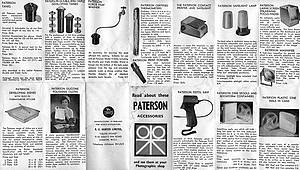 click to
enlarge click to
enlarge |
|
folds down to 112 x 55mm |
|
|||||||
|
|
|
Although not shown
in the above 1963 leaflet, by the latter 1960s Paterson were
selling a collapsible slide 'Pocket Viewer' for 35mm and 4 x 4cm
(superslide) slides, in 2"x2" mounts. A similar, larger, viewer is advertised in the above leaflet, for 2¼" (12 on 120 film) 6 x 6cm transparencies in 7 x 7cm mounts. The box containing the 2 x 2 viewer says "distributed by Johnsons of Hendon", so dates to after the 1965 take-over of R.F.Hunter by Johnsons. |
|||||||||
|
|
Amateur Photographer magazine for 30th August announced the inclusion by the Council of Industrial Design of Paterson lighting units, enlarging micro focus finder and CdS enlarging computer in the Council's design index, bringing the number of current Paterson products entitled to carry the Design Council label to well over 25. The micro focus finder was also included in the 'Design with Purpose' display in Interplas 67 as an outstanding example of British technical achievment in plastics fabrication. | ||||||||||
|
1973 |
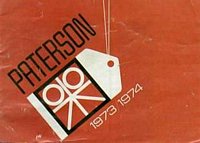 |
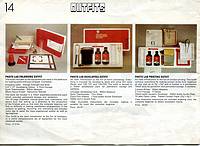 click to enlarge or download as a complete pdf |
front cvr |
Printed in England |
Paterson Products Sole UK Distributors Network Technical Distributors Ltd Colney Street, St Albans Herts |
||||||
 click to enlarge Paterson '35 Enlarger' prior to appearing in a Darkroom Outfit (see below). Processing equipment was initially sold separately, see back cover of brochure, above. The enlarger was given a Design Council Award in spring 1973 though was marketed from mid-January 1973 (see AP issue, 17th Jan 1973) |
|||||||||||
|
|
.jpg) |
.jpg) click to enlarge |
|
Printed in England Sweden) |
(Paterson products are made in England) No date but shows many of the illustrations as the 1973/74 Catalogue (above) |
||||||
|
|
 click to enlarge Possibly the first advert of a Paterson Darkroom Outfit Mainly intended for black & white; The enlarger has a filter drawer but not the later 'slide across' colour filters as appeared when the 35 Enlarger became the Colour 35 Enlarger (1981 ?). |
|
April 1974 |
Sole UK Distributors Network Technical Distributors Ltd Colney Street, St Albans Herts |
|||||||
|
|
 |
|
Printed in England |
|
|||||||
|
|
 click to enlarge |
|
December 1976 |
AcuCOLOR 2 (negative film developing kit) AcuCOLOR 3 (paper processing kit) and set of 16 Colour Printing Filters Rollei (UK) Ltd PO Box13 Wellingborough Northants NN8 2RG |
|||||||
|
|
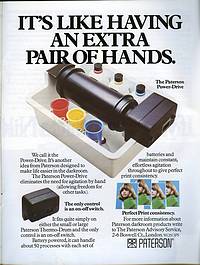 click to enlarge |
|
August 1979 |
Paterson Power-Drive fitted to Thermodrum colour print procesor 2-6 Boswell Court London WC1N 3PS |
|||||||
|
|
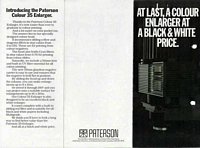 |
 click to enlarge |
|
2-sided leaflet, triple folded, advertising the new Paterson Colour 35 Enlarger and two darkroom kits |
further information contact Advisory Service 2-6 Boswell Crt London, WC1N 3PS |
||||||
|
(advertised as a complete 'darkroom in a box') was priced around £125. The advert features Acucolor Universal chemistry (rather than Acucolor 2 for films and Acucolor 3 for prints, as in 1976, see above). Acucolor Universal, like Photocolor II but unlike Paterson 2NA, see below, required a print additive when processing prints. |
|||||||||||
|
|
 click to enlarge |
|
June 1981 |
further information contact Advisory Service 2-6 Boswell Crt London, WC1N 3PS |
|||||||
|
|
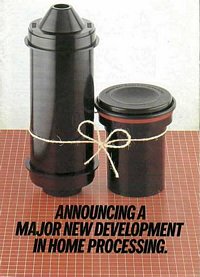 |
 click to enlarge |
|
Jacques Prod'homme 204x297mm 2-sided leaflet, four folds, advertising the Paterson Colortherm processor for films & prints, plus other colour print accessories Designed & produced by: Three's Company Ltd Birmingham, England. |
Paterson Products, 2-6 Boswell Crt, London, WC1N 3PS Tel: 01 405 2826 |
||||||
|
|
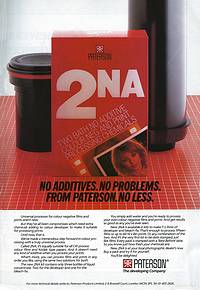 click to enlarge |
|
April & June 1984 |
The Developing Company Paterson Products Ltd 2-6 Boswell Crt, London, WC1N 3PS Tel: 01 405 2826 |
|||||||
|
|
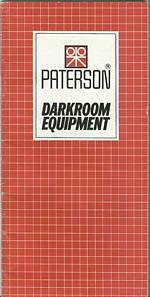 |
 |
|
Printed in England |
Darkroom Equipment Paterson Products Ltd 301-311 Rainham Road South Dagenham Essex, England |
||||||
|
1985 |
 |
 |
front & rear cvrs |
Printed in England Issued September 1985 |
Technical Information Paterson Products Ltd 301-311 Rainham Road South Dagenham Essex, England |
||||||
|
1985 |
 click to enlarge Note that this version of the Paterson Colour Darkroom is equipped with the Orbital processor (the Orbital appears in Paterson's July 1982 catalgue). In this form, the Outfit was available from September 1983. Originally (believed 1981) the Colour Darkroom had a print drum, see here. The inclusion of 2NA chemistry instead of the previous Acucolor Universal would have happened (presumably) around April 1984 (see 2NA above). |
|
December 1986 |
The Developing Company Paterson Products Ltd 301-311 Rainham Road South Dagenham Essex, England |
|||||||
|
|
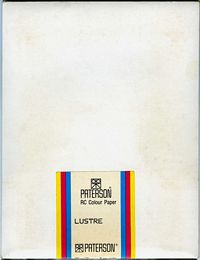 |
 |
A 25sheet, 5insx7ins, pack of
Paterson RC Colour Paper owned by Michael
Talbert, who says: This Lustre surface was almost identical to the Kodak 'E' surface, called Lustre Luxe. There would also have been a Glossy surface. The reverse has a label showing Exposure Factors, Red 37, Green 41, and Blue 23, for use with Tri-Colour (Additive) printing, and used when changing from one batch of paper to another. |
Paterson Products Ltd 301-311 Rainham Road South Dagenham Essex, RM10 8DH |
|||||||
|
|
 |
 |
front & rear cvrs |
CAT 957 |
Darkroom Equipment Elstree House Elstree Way Borehamwood Herts, WD6 1SD |
||||||
|
1998 |
 |
 |
incl cvrs |
Designed & produced by Icon Publications Ltd Kelso, Scotland, TD5 7BB. Printed in Scotland by Scottish County Press Ltd Bonnyrigg, Edinburgh |
Paterson Group Internat'l Ltd Stafford Park 1 Telford, Shropshire, TF3 3BT |
||||||
|
|
|
incl cvrs |
|
Unit 3, Malthouse Road Tipton, West Midlands, DY4 9AE http://www.patersonphotographic.com/wp-content/uploads/2017/12/paterson-darkroom-brochure.pdf |
|||||||
|
|
|
|
|
|
|
|
|
|
||
 Initially
Paterson equipment was just part of the very wide range of photographic
items (including the Rollei Twin Lens Reflex; TLR; camera range)
distributed by R.F.Hunter Ltd of 'Celfix House', Gray's Inn Road,
London, WC1.
Initially
Paterson equipment was just part of the very wide range of photographic
items (including the Rollei Twin Lens Reflex; TLR; camera range)
distributed by R.F.Hunter Ltd of 'Celfix House', Gray's Inn Road,
London, WC1. R.F.Hunter
Ltd were long time distributors of Paterson Products but in 1967
Johnsons of Hendon became Paterson's distributors. An entry in
'News of the Week' in Amateur Photography magazine for 4th January
1967.
R.F.Hunter
Ltd were long time distributors of Paterson Products but in 1967
Johnsons of Hendon became Paterson's distributors. An entry in
'News of the Week' in Amateur Photography magazine for 4th January
1967. ventually
took over the writing ourselves.
ventually
took over the writing ourselves.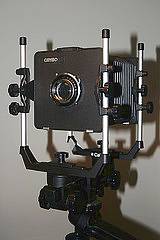 "In
the Boswell Court studio, we had a Leica M3 with retractable
Elmar lens for 35mm work, a Rolleiflex 'T' (75mm Tessar
~ the directors gave this to John Piggott when he left), and
a Mamiya C330 (interchangeable lens TLR) with 80mm and 180mm
lenses. Although the Rollei and Mamiya were both the same format
(2¼" square negatives, 12 on 120 roll film), they
produced quite different-looking results. Both had their advocates,
and both were favourites with the wedding photographers of the
day. I preferred the versatility of the Mamiya - it could go
close as well as take different lenses - but I admit the Rollei
build quality was silky-smooth in comparison."
"In
the Boswell Court studio, we had a Leica M3 with retractable
Elmar lens for 35mm work, a Rolleiflex 'T' (75mm Tessar
~ the directors gave this to John Piggott when he left), and
a Mamiya C330 (interchangeable lens TLR) with 80mm and 180mm
lenses. Although the Rollei and Mamiya were both the same format
(2¼" square negatives, 12 on 120 roll film), they
produced quite different-looking results. Both had their advocates,
and both were favourites with the wedding photographers of the
day. I preferred the versatility of the Mamiya - it could go
close as well as take different lenses - but I admit the Rollei
build quality was silky-smooth in comparison."



